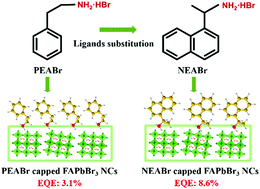Modulation of ligand conjugation for efficient FAPbBr3 based green light-emitting diodes†
Abstract
Organic ligands that capped the surfaces of perovskite nanocrystals (PeNCs) strongly influence the optical and electrical properties of the obtained PeNC films, which are fundamental for efficient perovskite light-emitting diodes (PeLEDs). Here, we systematically investigate the ligand effect through introduction of a ligand with strong π conjugation, 1-(1-naphthyl)ethylamine bromide (NEABr), for the fabrication of FAPbBr3 PeNCs. Compared to the widely applied ligand phenylethylamine bromide (PEABr), NEABr molecules containing naphthalene rings have more delocalized electrons and better conductivity, which is beneficial for charge injection and transportation between interfaces. By varying the ligand ratio, high quality three dimensional FAPbBr3 PeNC films with photoluminescence quantum yields up to 80% are fabricated. Based on the optimized PeNC films, electroluminescent (EL) devices achieve a maximum external quantum efficiency of 8.6%, which is about three times higher than that of EL devices based on PEABr. Importantly, by understanding the ligand effect, we demonstrate that the enhanced device efficiency is attributed to the lower defect densities and decreased interfacial resistance in the NEABr derived EL devices. Our findings about the effect of ligand conjugation on device performance may benefit other perovskite based optoelectronic devices.

- This article is part of the themed collection: 2020 Materials Chemistry Frontiers HOT articles


 Please wait while we load your content...
Please wait while we load your content...